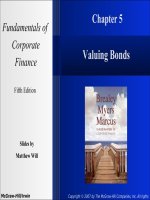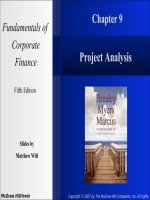Fundamentals of corporate finance 10e ROSS JORDAN chap010
Bạn đang xem bản rút gọn của tài liệu. Xem và tải ngay bản đầy đủ của tài liệu tại đây (1.34 MB, 60 trang )
Chapter 10
Making Capital Investment Decisions
10-1
McGraw-Hill/Irwin
Copyright © 2013 by The McGraw-Hill Companies, Inc. All rights reserved.
Chapter Outline
•
•
•
•
•
•
10-2
Capital Budgeting and Cash Flows
Incremental Cash Flows
Pro Forma Financial Statements
Operating Cash Flows
Replacement Decisions
Discounted Cash Flow Analysis
Chapter Outline
•
•
•
•
•
•
10-3
Capital Budgeting and Cash Flows
Incremental Cash Flows
Pro Forma Financial Statements
Operating Cash Flows
Replacement Decisions
Discounted Cash Flow Analysis
Capital Budgeting and
Cash Flows
In the previous chapter we focused on
multiple techniques of capital budgeting
to evaluate projects.
This chapter is all about how each of the
cash flows (CF’s) are determined.
10-4
Project Example - Visual
R = 12%
1
$ -165,000
CF1 = 63,120
2
3
CF2 =
CF3 =
70,800
91,080
The required return for assets of this risk level is 12% (as
determined by the firm).
10-5
Chapter Outline
•
•
•
•
•
•
10-6
Capital Budgeting and Cash Flows
Incremental Cash Flows
Pro Forma Financial Statements
Operating Cash Flows
Replacement Decisions
Discounted Cash Flow Analysis
Relevant Cash Flows
•
The cash flows that should be included in a
capital budgeting analysis are those that will
only occur (or not occur) if the project is
accepted
•
These cash flows are called incremental cash
flows
•
The stand-alone principle allows us to analyze
each project in isolation from the firm simply
by focusing on incremental cash flows
10-7
Asking the Right Question
You should always ask yourself: “Will this cash flow occur ONLY IF
we accept the project?”
•
If the answer is “yes,” it should be included in the analysis because
it is incremental
•
If the answer is “no,” it should not be included in the analysis
because it will occur anyway
•
If the answer is “part of it,” then we should include the part that
occurs because of the project
10-8
Common Types of Cash Flows
1. Sunk costs – costs that have accrued in the past
2. Opportunity costs – costs of lost options
3. Changes in net working capital (NWC)
4. Financing costs
5. Taxes
10-9
Common Types of Cash Flows
6. Side effects:
10-10
•
Positive side effects – benefits to other projects
•
Negative side effects – costs to other projects
Chapter Outline
•
•
•
•
•
•
10-11
Capital Budgeting and Cash Flows
Incremental Cash Flows
Pro Forma Financial Statements
Operating Cash Flows
Replacement Decisions
Discounted Cash Flow Analysis
Pro Forma Statements and Cash Flow
Definitions:
•
Operating Cash Flow (OCF) = EBIT + depreciation –
taxes
•
OCF = Net income + depreciation (when there is no
interest expense)
•
Cash Flow From Assets (CFFA) = OCF – net capital
spending (NCS)
– changes in NW
10-12
Project Pro Forma Income
Statement
Sales (50,000 units at $4.00/unit)
Variable Costs ($2.50/unit)
125,000
Gross profit
$ 75,000
Fixed costs
12,000
Depreciation ($90,000 / 3)
30,000
EBIT
Taxes (34%)
Net Income
10-13
$200,000
$ 33,000
11,220
$ 21,780
Chapter Outline
•
•
•
•
•
•
10-14
Capital Budgeting and Cash Flows
Incremental Cash Flows
Pro Forma Financial Statements
Operating Cash Flows
Replacement Decisions
Discounted Cash Flow Analysis
Projected Capital Requirements
Year
NWC
Net FA
Total
10-15
0
1
2
3
$20,000
$20,000
$20,000
$20,000
90,000
60,000
30,000
0
$110,000
$80,000
$50,000
$20,000
Projected Total Cash Flows
Year
0
OCF
Change in
1
$51,780
2
$51,780
-$20,000
3
$51,780
20,000
NWC
10-16
Net CS
-$90,000
CFFA
-$110,00
$51,780
$51,780
$71,780
Project Example - Visual
R = 20%
1
$ -110,000
CF1 = 51,780
2
3
CF2 =
CF3 =
51,780
71,780
The required return for assets of this risk level is 20% (as
determined by the firm).
10-17
Using your calculator
10-18
Evaluate the Project
Enter the cash flows into the calculator
and compute NPV and IRR:
CF0 = -110,000; C01 = 51,780; F01 = 2;
C02 = 71,780; F02 = 1
NPV; I = 20;
CPT NPV = $10,648
CPT IRR =
10-19
25.8%
What’s Your Decision?
So….Deal or No
Deal?
10-20
More on NWC
Why do we have to consider changes in NWC separately?
GAAP requires that sales be recorded on the income statement when
made, not when the cash is received.
GAAP also requires that we record the cost of goods sold when the
corresponding sales are made, whether we have actually paid our
suppliers to date.
Finally, we have to buy inventory to support sales, although we
haven’t collected cash yet.
10-21
Depreciation
The depreciation expense used for capital budgeting should be the
depreciation schedule required by the IRS for tax purposes
Depreciation itself is a non-cash expense; consequently, it is only
relevant because it affects taxes
Calculation:
Depreciation tax shield = DT
D = depreciation expense
T = marginal tax rate of the firm
10-22
Computing Depreciation
Straight-line depreciation
D = (Initial cost – salvage) / number of years
Very few assets are depreciated using the straight-line method for tax
purposes
MACRS
Need to know which asset class is appropriate for tax purposes
Multiply percentage given in table by the initial cost
Depreciate to zero
Mid-year convention
10-23
After-tax Salvage
If the salvage value is different from the book
value of the asset, then there is a tax effect
Book value = initial cost – accumulated
depreciation
After-tax salvage = salvage – T*(salvage – book
value at time of sale)
10-24
After-tax Salvage Computation
1.Market Value – Book Value = gain (or loss)
2.Take gain (or loss) x (marginal tax rate)
3.Pay taxes on a gain; Receive a tax benefit on a loss
4.After-tax Salvage =
Market Value – taxes paid or
Market Value + tax benefit
10-25









